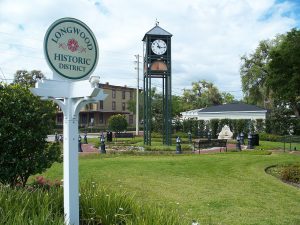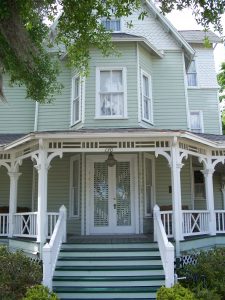Longwood
 Central Florida’s development began after the Second Seminole War (1837-1842). By the early 1860s, both Sanford and Orlando were small settlements that had developed near the Seminole War forts built between 1837 and 1838.
Central Florida’s development began after the Second Seminole War (1837-1842). By the early 1860s, both Sanford and Orlando were small settlements that had developed near the Seminole War forts built between 1837 and 1838.
The earliest settlers to the Longwood area arrived in the early 1870s. John Neill Searcy came from Tennessee in March of 1873, and Edward Warren Henck arrived from Boston in November of the same year. Both came by steamboat up the St. Johns River to Sanford and were soon granted Longwood homesteads. A small community had begun to develop.
In 1876, Henck obtained a Post Office for the community which he named Longwood after an attractive suburb of Boston. Henck was the first Postmaster, serving from 1876 to 1885.
Established in 1878, Longwood is the oldest city in Seminole County.
In 1880, Henck led a group of local businessmen in getting the first post-Civil War railroad, the South Florida Railroad, constructed in Florida. It ran from Sanford to Orlando. He also initiated construction of the Longwood Hotel, which was completed in 1886. Henck was elected Longwood’s first mayor in 1885.

Another early settler from Boston, Frederick Rand, together with the Searcy family, founded Christ Episcopal Church. Rand’s parents raised funds in Boston to assist with building of the church. Rand was also associated with Henck and the founding of the railroad.
Although the railroad from Sanford to Jacksonville was not completed until the mid- 1880’s, the railroad from Sanford to Orlando, completed in 1880, increased access to the area for those who arrived by steamship. Growth was rapid, and by 1886 the population was 1,000. Longwood was among the largest communities in Orange County (Seminole County was formed in 1913).
Russian immigrant P.A. Demens came to Longwood in 1881 and bought a small sawmill which he quickly expanded. It provided lumber and related materials for much of the construction in the mid-1880’s. Demens also founded the Orange Belt Railroad which was completed from Sanford to the Tampa Bay area in 1886. The terminus was named St. Petersburg by Demens, after his birthplace in Russia.
The Great Freeze of December 1894 and January 1895 had a devastating impact on the citrus industry and caused a major exodus from Central Florida. By the 1900 census, Longwood’s population had declined to 325.
During the 1910-1920 period, the area started to grow again, and by the mid-1920’s the Boom Era was at its peak. In 1923 the Town of Longwood was incorporated as a city, and the Dixie Highway was constructed near where County Road 427 is located today.
With the coming of the Depression, development stopped. The City’s only bank failed in 1932 and Longwood sought, unsuccessfully, to disincorporate. Toward the end of the 1930’s, some growth did occur, and by the 1940’s the population of the incorporated city was 406. With the growth of Central Florida during the 1970’s and 1980’s, Longwood developed into primarily a residential community, and by 2000, the population exceeded 13,700.
